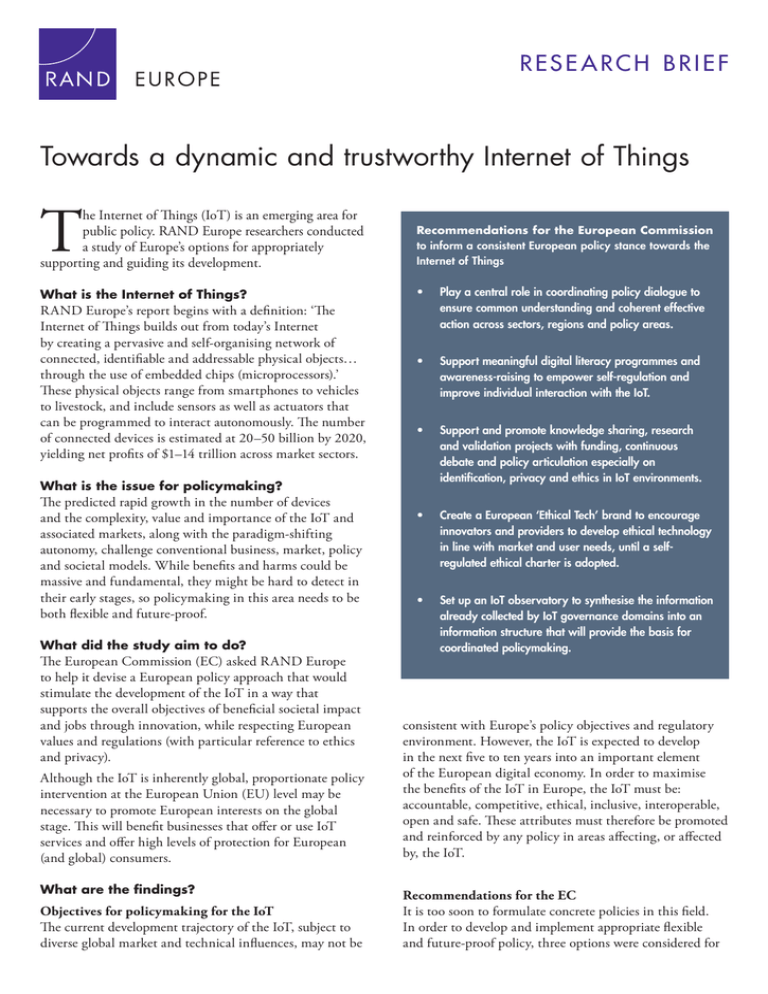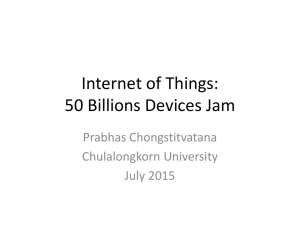T Towards a dynamic and trustworthy Internet of Things
advertisement

RESE ARCH BRIEF Towards a dynamic and trustworthy Internet of Things he Internet of Things (IoT) is an emerging area for public policy. RAND Europe researchers conducted a study of Europe’s options for appropriately supporting and guiding its development. T Recommendations for the European Commission to inform a consistent European policy stance towards the Internet of Things What is the Internet of Things? • Play a central role in coordinating policy dialogue to ensure common understanding and coherent effective action across sectors, regions and policy areas. • Support meaningful digital literacy programmes and awareness-raising to empower self-regulation and improve individual interaction with the IoT. • Support and promote knowledge sharing, research and validation projects with funding, continuous debate and policy articulation especially on identification, privacy and ethics in IoT environments. • Create a European ‘Ethical Tech’ brand to encourage innovators and providers to develop ethical technology in line with market and user needs, until a selfregulated ethical charter is adopted. • Set up an IoT observatory to synthesise the information already collected by IoT governance domains into an information structure that will provide the basis for coordinated policymaking. RAND Europe’s report begins with a definition: ‘The Internet of Things builds out from today’s Internet by creating a pervasive and self-organising network of connected, identifiable and addressable physical objects… through the use of embedded chips (microprocessors).’ These physical objects range from smartphones to vehicles to livestock, and include sensors as well as actuators that can be programmed to interact autonomously. The number of connected devices is estimated at 20–50 billion by 2020, yielding net profits of $1–14 trillion across market sectors. What is the issue for policymaking? The predicted rapid growth in the number of devices and the complexity, value and importance of the IoT and associated markets, along with the paradigm-shifting autonomy, challenge conventional business, market, policy and societal models. While benefits and harms could be massive and fundamental, they might be hard to detect in their early stages, so policymaking in this area needs to be both flexible and future-proof. What did the study aim to do? The European Commission (EC) asked RAND Europe to help it devise a European policy approach that would stimulate the development of the IoT in a way that supports the overall objectives of beneficial societal impact and jobs through innovation, while respecting European values and regulations (with particular reference to ethics and privacy). Although the IoT is inherently global, proportionate policy intervention at the European Union (EU) level may be necessary to promote European interests on the global stage. This will benefit businesses that offer or use IoT services and offer high levels of protection for European (and global) consumers. What are the findings? Objectives for policymaking for the IoT The current development trajectory of the IoT, subject to diverse global market and technical influences, may not be consistent with Europe’s policy objectives and regulatory environment. However, the IoT is expected to develop in the next five to ten years into an important element of the European digital economy. In order to maximise the benefits of the IoT in Europe, the IoT must be: accountable, competitive, ethical, inclusive, interoperable, open and safe. These attributes must therefore be promoted and reinforced by any policy in areas affecting, or affected by, the IoT. Recommendations for the EC It is too soon to formulate concrete policies in this field. In order to develop and implement appropriate flexible and future-proof policy, three options were considered for likely efficiency and efficacy in achieving the EC’s policy objectives: ‘do nothing’, ‘soft law’ and ‘hard law’. Overall, a soft law policy stance is suggested as the best way to create space for IoT development and to accelerate or improve development of the IoT market. The report provides a number of recommendations for the EC concerning coordination, knowledge sharing and engaging consumers (see Box overleaf). Building an ethical IoT A unique attribute of the IoT that has extensive ethical implications is the creation of new forms of contact among organisations, individuals and things. It is increasingly difficult for those with responsibilities to know, understand and control these connections; the classical protections of negotiation, markets and contracts may not work as well for human-to-machine, let alone machine-to-machine, contacts. The researchers considered these ethical issues in relation to privacy, autonomy, trust, identity and social inclusion, and note that more attention must be paid to improving individual understanding and awareness, so that citizens can be part of continuous debate and policy development as the IoT and its associated technologies develop. Innovators and providers are urged to adopt self-regulation for development of ethical technology in line with market and user needs. A note on study methods The researchers first developed a working definition of the IoT (see overleaf) and assessed the current state of play and likely medium-term developments from technological, economic and policy points of view, both inside the EU and globally (in particular in China, Japan and the United States). From this they developed a matrix of potential policy approaches and a set of recommendations. The study was informed by a literature review, key informant interviews and an internal scenarios-based workshop. The findings and conclusions were validated and extended at an open stakeholder workshop in Brussels in 2013. For the full report and other resources: See www.randeurope.org/iot This research brief describes work funded by the European Commission (DG CONNECT) and documented in Europe’s policy options for a dynamic and trustworthy development of the Internet of Things, ISBN 978-92-79-30788-1, DOI: 10.2759/22004, by Helen Rebecca Schindler, Jonathan Cave, Neil Robinson, Veronika Horvath, Petal Hackett, Salil Gunashekar, Maarten Botterman, Simon Forge & Hans Graux, RR-356-EC, 2013 (available at www.rand.org/pubs/research_reports/RR356). The brief was written by Claire O’Brien. RAND Europe is a not-for-profit research institute whose mission is to help improve policy and decisionmaking through research and analysis. RAND Europe’s publications do not necessarily reflect the opinions of its research clients and sponsors. R® is a registered trademark. www.randeurope.org RB-9742-EC (2013) CHILDREN AND FAMILIES EDUCATION AND THE ARTS The RAND Corporation is a nonprofit institution that helps improve policy and decisionmaking through research and analysis. ENERGY AND ENVIRONMENT HEALTH AND HEALTH CARE INFRASTRUCTURE AND TRANSPORTATION This electronic document was made available from www.rand.org as a public service of the RAND Corporation. INTERNATIONAL AFFAIRS LAW AND BUSINESS NATIONAL SECURITY POPULATION AND AGING PUBLIC SAFETY SCIENCE AND TECHNOLOGY TERRORISM AND HOMELAND SECURITY Support RAND Browse Reports & Bookstore Make a charitable contribution For More Information Visit RAND at www.rand.org Explore RAND Europe View document details Research Brief This product is part of the RAND Corporation research brief series. RAND research briefs present policy-oriented summaries of individual published, peer-reviewed documents or of a body of published work. Limited Electronic Distribution Rights This document and trademark(s) contained herein are protected by law as indicated in a notice appearing later in this work. This electronic representation of RAND intellectual property is provided for non-commercial use only. Unauthorized posting of RAND electronic documents to a non-RAND Web site is prohibited. RAND electronic documents are protected under copyright law. Permission is required from RAND to reproduce, or reuse in another form, any of our research documents for commercial use. For information on reprint and linking permissions, please see RAND Permissions.






